History of Lwitikila Girls Secondary School
The school began as the Sacred Heart School at Ilondola in Chinsali District. The first classes were taken by Sister John Eudes and Sister Agnes in August 1961.
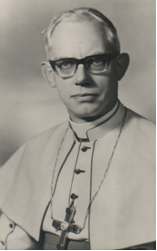
Bishop Fuerstenberg
Meanwhile His Lordship Bishop Furstenberg, and Father O’Riordan, the Education Secretary General, chose the present site for the school, near the Chinsonkolo Falls, Mpika. In January 1962 Keegan and Smith Construction Company began to clear the bush, and to build the first classrooms and dormitories. They named the first road through the site after Cairo Road in Lusaka.
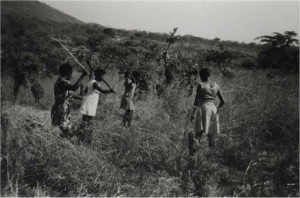
The girls helped to clear the ground to build the school
In August 1962 the sixty girls were transferred from Ilondola and Sister Euphemia was appointed Principal. Two classrooms, one dormitory block, one dining room and kitchen were then in use. In 1963 Father Kohle, who was then in charge of the mission blessed the school buildings
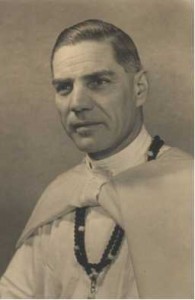
Father van den Acker
The first girls had to work very hard to clear the surrounding bush. They were greatly helped by Father van den Acker. He was then Manager of Schools for the District and resided at the Mission with Father Kohle. He was a very enthusiastic landscape gardener. It was he who laid out the school grounds and planted many of the fruit trees and ornamental trees. Father cleared some areas for Netball and Rounders. He also made a temporary swimming pool at the Falls by deepening and building around the natural pool there. We used this pool until 1968.
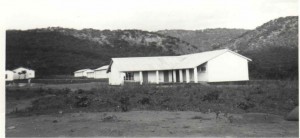
First class rooms
After Independence in 1964, the school was renamed Lwitikila Girls’ Secondary School. By 1965 the school buildings had increased to two dormitory blocks, eight classrooms, two general science rooms, a domestic science room, two dining room blocks, and an administrative block. Mr. Gerd, a member of a German volunteer organisation, mad the bricks for the school buildings. Mr. Anton, another lay helper installed the first diesel engine for the light.
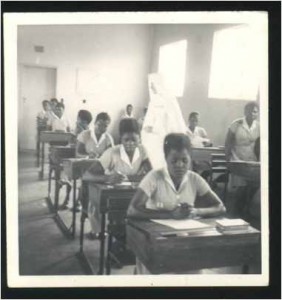
First class
In May 1965 the first Lay Mission Associate Teachers came to Lwitikila, Mr and Mrs Patrick James and Mr and Michael Davis. In the same year the first teachers from Voluntary Service Overseas organisation (V.S.O.) arrived; Miss Nuala Breen and Miss Patricia Smith. They were the first group of teachers to take evening classes at Mpika.
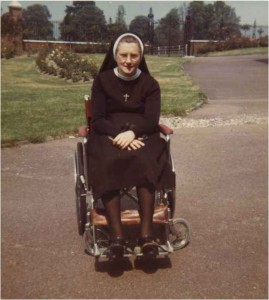
Sister Stephen taught science
Unfortunately on 7th September 1965, our Science teacher, Sister Stephen was seriously injured in a car accident at Mpika, and had to return to Britain.
In January 1966 three classes of Form 1 girls were admitted, and the first Form 3 class was started. The numbers had now increased to 220. In the same year a House System was introduced. The four houses were:
(Madam) Curie – now Buyantanshi – Captain Anna Ngambi
(Helen) Keller – now Chimwemwe – Captain Cornelia Chakulimba
(Anna) Frank – now Muleya – Captain Hilary Mulenga
(Mary) Kingsley – now Kwacha – Captain Veronica Kateule
The first head-girl was Barbara Chonya and her assistant was Margaret Sokoni.
When the House system was introduced, the head-girl and captains were appointed by Staff, but in 1967 elections were introduced. In 1967 nominations were made by staff, and the girls elected their leaders from these. As from 1969 twelve Form 5 girls have been nominated by the girls. These nominations have been short-listed to six by staff, and a head-girl elected from these six by the girls. Captains were elected by girls of that house. The nominees are the prefects of that year. Prefects are elected in houses from nominations made by House Mistress, House Captain and outgoing prefects. Each year the prefects and captains have an outing.
First Sports Day:
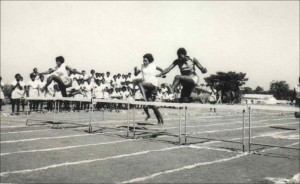
110 meters hurdles
On 1st August 1966, the first Sports Day based on the House system was organised by sister Immaculata and Miss Smith. Father Lauzon, the Education Secretary, presented the cup to the captain of the winning house, which was Buyantanshi.
In 1967 two more houses were opened:
(Edel) Quinn – now Chisokone – Captain Hilda Kaunda
(Gladys) Aylward – now Buseko – Captain Mary Sichinga.
The Church:
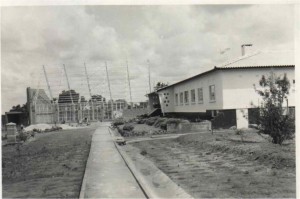
Chapel being built
During the first years Mass was said in a room in the convent, but in 1965, His Lordship Bishop Furstenberg started the building of the present church, which was designed by Brother Koch. It was opened in august 1965.
Death of First Principal:
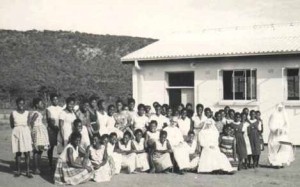
Sister Euphemia (Principal) and Sister John Eudes, Bishop Fuerstenberg with some of the first pupils
On 13th September 1966, Sister Euphemia, who had done so much to develop the school, was killed in a car accident at Serenje. May she rest in peace. She is buried at the school.
About the same time Miss Breen and Miss Smith left and Miss Lyn Walker, Miss Philippa Dixon and Miss Elizabeth Bradill arrived.
The Open air Theatre:
In 1966 Sister Euphemia had suggested that as the school had no place for assemblies, we should try to have and open air theatre. Mr. Patrick James, who was himself very keen on Drama, agreed to take on the project.
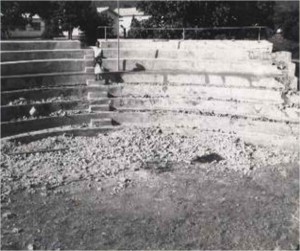
Open theatre taking shape
Plans for the theatre gradually developed. The girls helped to clear an area opposite the classrooms. Tuck-shop profits and a gift of K100 from Mpika Rural Council helped to pay for the Theatre.
Mr Rudi Adler, a German volunteer, installed the lights. In 1971 Mr Manfred, another German volunteer rewired the whole theatre.
The Sports Day organised by Miss Dixon was held on 29th March to coincide with the opening of the Theatre. The play ‘Merchant of Venice’ was performed by the staff and girls, with Mr James himself playing the part of Shylock.
About the same time the Form 5 bedrooms, the laundry and the dormitory storerooms were built with help from the tuck-shop profits. Through the generous financial help of the Sisters, Chigwell, England, cement paths were laid to connect classrooms, dormitories and dining rooms.
The Track:
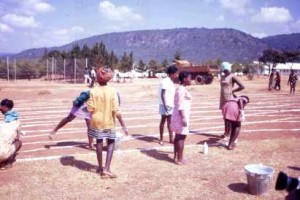
Tracks building
During the early years Father van den Acker had cleared and prepared grounds for Netball and Rounders. In 1967 Mr. Michael Davis started the clearing of an area of bush for a 400 metre track. It was a very formidable undertaking, as there was a difference of six metres between the highest and lowest points in the area concerned.
Friends, especially Mr Bruno, who later became the husband of Miss Rose Wilks, a teacher at the school, helped Mr. Davis. They were working at the Frederici Road Camp at the time, tarring the Great North Road. They brought two bull dozers for some days to remove rocks and soil and to try to bring up the level.
The Roads Department, Mpika also helped by giving their bull dozer and grader for some time. Sister Immaculata and the Maths class did the practical work of finding the right angles in the bush. A donation from the Mining Companies helped to pay the expenses. Before Mr Davis left in December 1968, he managed to lay out the track very much as it is today.
The Swimming Pool:
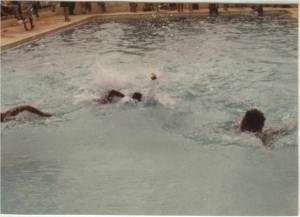
Swimming pool
In October 1967, Mr James, after spending the entire month’s school holiday preparing and tarring the Assembly place, started plans for the swimming pool.
It was decided to dig it on what used to be the Rounders Pitch. The girls were very generous with their help, and collected stones for the foundations. It was the hot season, and the work was very tiring, but each girl really did her best. Friends from Frederici Camp again helped by giving us some loads of crushed stone. It was hoped to have the pool ready for official opening in 1968, but as certain materials were not available, it was not opened till 1969. Expenses were again met through gifts from friends both here and overseas.
Visit of His Excellency, the President:
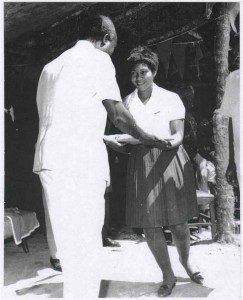
President tour in Lwitikila
Among the many distinguished visitors to the school over the years, we were extremely pleased and honoured to welcome our President, H.E. Dr Kenneth Kaunda, in 1968. He very kindly remembered us by sending a generous donation for the swimming pool.
School Clinic:
About this time, the school clinic was reorganised. What is not the English Department Room was then used as a clinic. But in 1967 a room was adapted for the purpose in the dormitories.
All through the years, the Sisters and Doctors of Chilonga Hospital have helped us in every way, coming over regularly for medicals, helping us with medicines, and more especially through their patience with all the calls we make on them at all times.
The Boarding side of the school was reorganised and very well run by Sister Christine Lombe, who was Boarding Mistress for several years.
Other Sports Days:
On 31st May 1968, sports Day was organised by Miss Due Dale, who had replaced Miss Dixon in 1967. Miss Dale also took the leading part in the play that night. The play was ‘Macbeth’ and was performed by the staff and girls. Mr Patrick James directed the play. Miss Dale left Zambia the following day to be married in England on 6th June. The Form 5 girls helped to make her wedding dress.
The track was used for the first time in September 1969 for the Sports Day. Miss Lynn Walker marked out the whole track and organised the Sports Day. For the first time swimming events were included in the programme.
Miss Aine Jordan with the help of Sister Edmund and Miss Wisdom organised a variety concert in the evening.
House Gardens:
Between 1967 and 1968 Father van den Acker measured the school grounds for fencing. At that time he also planned the House gardens. Each house was allotted an area which they cleared of bush. Water was then connected to each garden.
Water Affairs:
In the first years of the school, the water supply was sufficient for the needs of our small number of girls. As the school developed, however, so did our water problem. At the beginning we had two hydrams pumping water into a reservoir built on elevated ground above the dormitory area. A while later another hydram was added, and a second reservoir was built to take the overflow from the first.
In 1968 the concrete water tank at the Falls cracked so badly, that the water had to be turned off for some time. Most of the girls who lived nearby went home while the tank was repaired. Brother Burkhard kindly agreed to build another tank.
In 1969-1970 the water shortage was very acute. The girls had to go to the Falls for washing up. Drums of water had to be brought up from the Falls for kitchen and staff houses. The Ministry of Education helped by giving us funds towards the purchase of a Diesel pump. The D.D.C. Mpika, helped us with piping. The water supply remained inadequate, and very often the top dormitories and the staff houses had no water.
New Water Supply:
We were very fortunate to get money from the Department of Water Affairs in Kasama, and the expert help of Brother Bernard. He spent many weeks seeking a satisfactory and lasting solution to our water problem.
Brother Bernard discovered ten underground streams in a mushitu in the hills about one mile north-west of the school. He and his men very laboriously cut through the rock bed, in order to divert the individual streams into a concrete well which he made. The bags of cement had to be carried up the steep hill side. Lower down the hiss, Brother discovered another seven streams, and carried out the same process there. The water now reaches our reservoir through the force of gravity alone. No machinery or pumps are needed. The girls followed every stage of this fascinating process as part of their Geography studies.
Mr John Rhoda:
From 1969 – 1971 we enjoyed the company and assistance of Mr John Rhoda. Mr Rhoda was employed by Wijnberg Construction Company, and was building Mpika Boys’ Secondary School at this time. In his free time he supervised many of our buildings and projects. In 1969 he built the P.E. Dressing Room, and the store room which Miss Walker wanted for the P.E. equipment. This equipment included the 24 hurdles which Mr Rhoda very kindly made for us.
In the same year he built the two chicken houses which Mr John wanted for his Agricultural Science lessons. Mr John had just started Agricultural Science in the school and wanted to keep the department separate from the Young Farmers Club.
Mr Rhoda was also responsible for the building of the Domestic Science Flat and two staff houses. He also supervised the construction of the Commercial Room which was built to Sister Edmund’s specifications. Again we were very fortunate to receive donations from home and overseas to meet the cost of these buildings.
Agricultural Science:
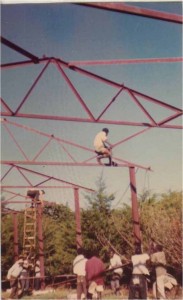
Agricultural science room taking shape
In January 1970 Miss Ann Weaver joined the staff and developed the agricultural Science Department. She was responsible for clearing the bush in front of Buseko and building another block of chicken houses. The girls with Miss Weaver’s help built rabbit houses, a duck pond, and an enclosure for pigs. Broilers, pigs, rabbits and ducks were bought. Later layers were also started, and soon we had eggs on the menu for the first time.
Miss Weaver was very keen to have an Agricultural Science Room, and eventually the Ministry of Education released funds for this purpose. June 1971 saw the work begin, after Miss Weaver had made some drawings of what she wanted. Mr. Mike Perry and Father Lavertu supervised the erection of the steel framework. The building was begun by Mr Rhoda, and taken over at window level by Brother Gotleib. Since funds were not sufficient to cover the cost of furniture, the Science Department agreed to use the room for both Ag. Sc. and Biology. Brother Bremaud did the difficult task of changing the work benches from the old Biology lab and installing gas and water.
Geography Room:
The Geography Department has also been anxious to have a room of their own, and this now became possible. The old Biology lab was modified slightly after the removal of the work benches, and this became the Geography Room.
Sports Days 1970 and 1971:
In July 1970 the Sports day was organised by Miss Walker helped by Miss Jill Manley, who had joined the staff the previous September. Miss Jordan organised the evening concert, which included two one act plays from the African Writers Series, and tribal dancing by the School Tribal Dancing group, which she herself looked after. The programme also included a selection of songs by the school choir trained by Miss Hargaden, and Indian dances taught by Mrs Anthony.
In 1971, Miss Penny Watt, who had replaced Miss Manley organised the Sports Day, and also helped to make the costumes for the play ‘Everyman’ which Miss Jordan produced for the evening concert. Again the school Tribal Dancing group and Miss Hargaden’s choir took part in the concert.
History Department:
In 1970 the History syllabus was changed. The first part of the new syllabus is concerned mainly with local history. Miss Theresa Booth started this syllabus, but unfortunately she had to return to Britain because of ill health.
The Museum:
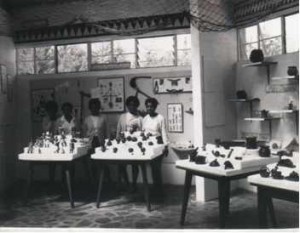
Museum
When Miss Christine MacKinnon took over the History Department in September 1971, she was very enthusiastic about the amount of local material available for lessons, but was sorry that there was no permanent place in which to use and display it effectively.
After a visit to Father Corbeil’s museum in Isoka in October, she began to think of a combined History Room cum Museum. Father Corbeil very kindly gave a valuable part of his own collection for her lessons. This material was kept in the Religious office, which was the only available lace. Articles had to be carried to and from the classroom. Miss MacKinnon with the help of Father Carey who had been teaching History since Miss Booth’s departure made rough plans for a room based on a traditional Bemba nsaka. Bishop Furstenberg also gave valuable advice. However since there were no funds available for the project, plans were put aside for a while.
In December, the Sisters in Mbala, hearing about the plans made a very generous donation. The original drawings were then sent to Brother Koch who made the final plans. Brother Loesch agreed to build the Museum.
In February 1972, since Brother Loesch was still working in Mulanga, Father Piwek started the building and brought it up to window level. The girls very generously collected stones for the foundation. Brother Bremaud made the beautiful steel roof, which was finished in a record time of three days just before Easter.
Father Corbeil:
Father Corbeil proved himself a true and trusted friend at every stage of the planning, construction and furnishing of the Museum. Not only did he give such a large part of his own collection, he also gave illustrated lectures to every class in the school to encourage appreciation of and enthusiasm for traditional Zambian culture.
Father spent much of July 1972 arranging and displaying the different sections of the Museum.
Tragically before the building was complete, Miss MacKinnon died in a road accident. May she rest in peace.
Sports Day 1972:
In July 1972 the Sports Day was organised by Miss Allison Hodges, who had replaced Miss Watt. Mrs Goes directed the evening concert, which included once again and East African Play, tribal Dancing and Miss Hargaden’s choir.
The School Hall:
Since the opening of the school, there had been no place apart from the theatre, large enough to accommodate the whole school so in April 1972 plans for building a School Hall began.
Through the very generous financial help of the Sisters in Chigwell, England; through gifts from the Mining Companies and also through individual donations including the sponsored cycle ride from Lwitikila to Kitwe in August by Miss Breda Cavanagh, we were able to meet some of the cost of the Hall.
The steel framework was erected in July. We were very fortunate to have the expert assistance of Mr Katongo P.W.D. who supervised the laying of the slab and brought the building up to window level during his month’s holiday. At the same time he supervised the building of a new staff house.
When Mr Katongo’s leave was finished, the work was supervised by the school kapitao, Mr Cleto Mutale, with the very kind and expert advice of Father Piwek and Brother Bremaud. Mr Manfred, a German volunteer, did a splendid job of the electrical installation. Brother Burkhard came from Mulanga to supervise the laying of the floor. There was great difficulty and delay in obtaining ceiling board as the border crisis had intervened meanwhile. However the Hall was finished just one week before Sports Day 1973. Mr Mutale also prepared the surrounding grounds, planted trees and grass, and extended the school fence to include the hall and the school gardens. We now have a School Hall of which we are very proud.
The Cold Room:
In 1972 another long awaited project was started – the Cold Room for the Boarding Department. With help from various trusts we were able to buy the freezing equipment. Father Lauzon in particular, was most helpful in seeing this project started.
In 1970 The Permanent Secretary, Kasama had asked each school to run its own school Production Unit, a farm of several acres and a poultry unit. Since then we have planted some maize, potatoes, ground nuts and vegetables each year. In February 1972 we built new poultry houses for broilers and layers. However there was always difficulty in preserving produce during the holidays. Brother Bremaud very kindly agreed to take on the extremely difficult task of converting already existing store rooms into the Cold Room which is of such great help to the Domestic side of the school.
The Maths Room:
Over the years while new buildings were going up all round, Sister Immaculata who had been teaching in the school since 1965, had often expressed the wish to have a Maths room. In May 1972 Brother Loesch combined two rooms to make the present Maths room to Sister Immaculata’s specifications. We are very pleased to have this room in which to make and display projects which are of so much help to other classes.
The Mathematics Association of Zambia of which Lwitikila is a corporate member, started a Problems contest in 1969. Each year the school has participated and Lwitikila is very proud of the following girls who did well in the contest each year;
1969 Helen Mukangwa then in Form 4
1970 Prisca Harry then in Form 5
1971 Emeira Nkonde then if Form 4
1972 Imelda Ngosa then in Form 4
In 1971 the contest was extended to include Kenya, Tanzania and Uganda. In 1972 Imelda Ngosa qualified for entry to the International Contest.
THE VIEW OF THE SCHOOL AS IT IS NOW:
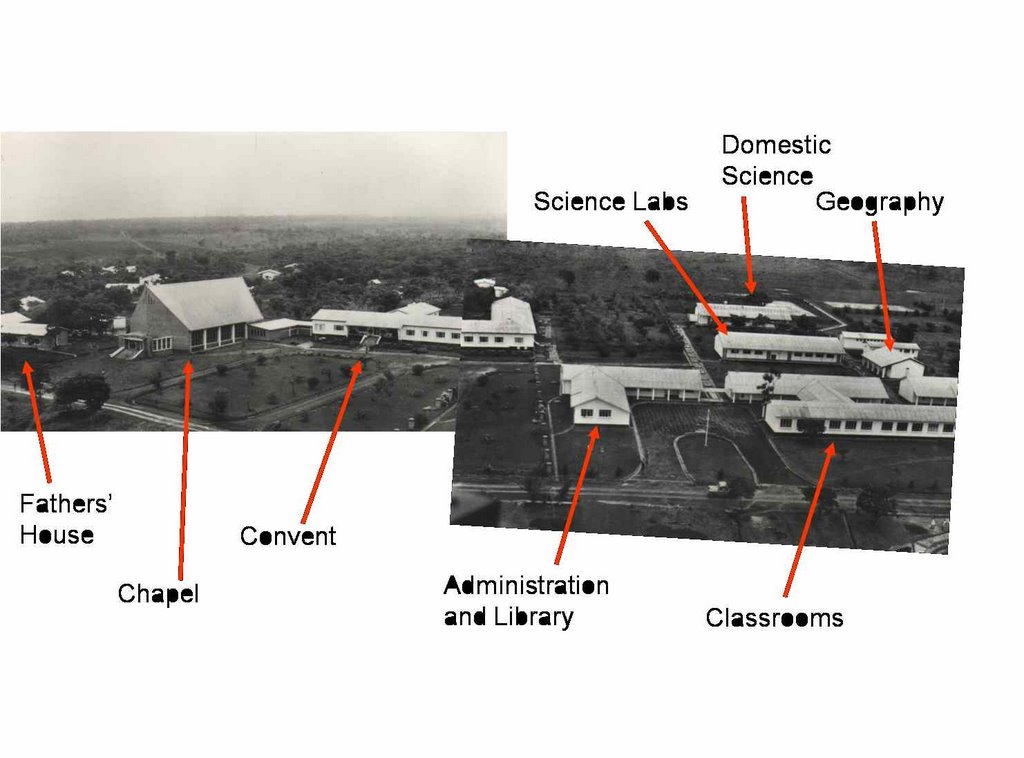
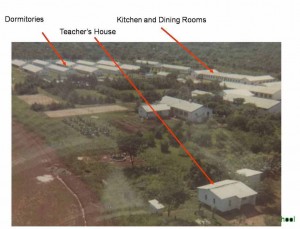
Staff from 1961
1961 Education Secretary, Father Reuter; Sister John Eudes; Sister Agnes.
1962 Sister Imelda, Sister Euphemia
1963 Sister Vincent
1964 Education Secretary, Father Lauzon; sister Austin, Sister Stephen.
1965 Sister Immaculata, Mr & Mrs Patrick James; Mr & Mrs Michael Davis; Miss Nuala Breen; Miss Patricia Smith; Sister Stanislaus.
1966 Sister Madga Marie; Mill Elizabeth Bardill; Miss Phillipa Dixon; Miss Lynn Walker.
1967 Father van Dorst; sr. Perpetua; Miss Joan Hanley; Mr John Nedungatt; Miss Rose Wilks; Miss Sue Dale; Sister Benignus; Miss Muriel Wisdom; Sr Christine Lombe; Sister Rejeanne.
1968 Sr. Scholastica; Miss James; Miss Theresa Booth.
1969 Fr. Carey; Miss Aine Jordan; Mr & Mrs Anthony; Mrs John; Mr T. Thomas; Sr Edmund; Miss Aileen MacArdle; Miss Breda Cavanagh; Miss Jill Manely; Miss Madeline Hume; Sr Mary Pikiti; Sr Kevin.
1970 Miss Catherine Hargaden; Mill Ann Weaver; Mr & Mrs Liam Hayes; Miss Penny Watt.
1971 Mr & Mrs John McCann; Me & Mrs Gerard Thomas; Sister Simeon; Miss Allison Hodges; Miss Mary Underwood; Miss Christine MacKinnon; Miss Elizabeth Grant; Miss Eleanor Stewart; Miss Margaret Bradley; Miss Eunice Malama.
1972 Education Secretary Father Kayunge; Mr & Mrs Tom Hughes; Mr & Mrs Dick Parsons; Miss Mary Chibwabwa; Miss Eileen Kenny, Miss Helena Dolney; Sr John Vianney.
1973 Mrs Ayers, Mrs Joy; Miss Kairitha, Sr Devota; Sr. Hyacintha.
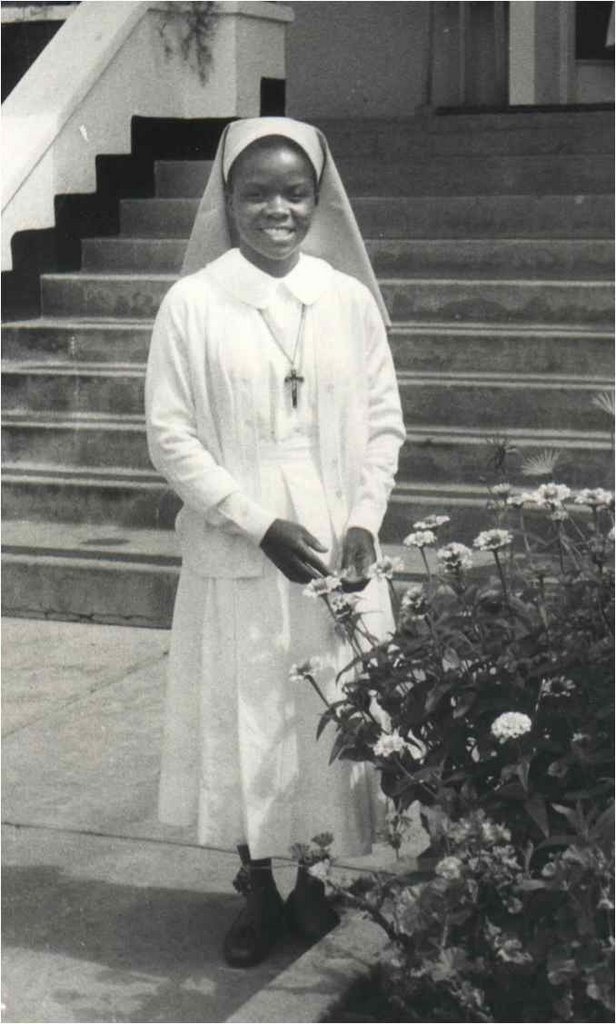
Sister Christine Lombe SCJ first boarding mistress
Ancillary Staff
Among those who deserve very special mention are:
Mr Creto Mutale, our kapitao, who has proved himself a very devoted and skilful foreman ever since he came to the school in 1966. He also founded the Lwitikila Savings Co-operative, and was its first Treasurer.
Mr Jacobo Mutema, the school driver since he came to the school in 1967. He has been called on at all hours for all kinds of work, and has always been trustworthy and reliable. He worked many long hours in the execution of the various projects.
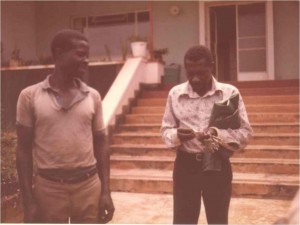
Evaristo and Mamerto Head Cook and Foreman
1965 Mr Evaristo Katongo; Mr Mariko Kaonda
1966 Mr Muma Seba
1967 Mr John Paundi; Mr Mamerto Mulenga
1968 Mr Timothy Katongo
1970 Mr Wilson Engini
1972 Mr John Marko Mutale; Mr Peter Keto
1973 Mr Peneshi Chengo
